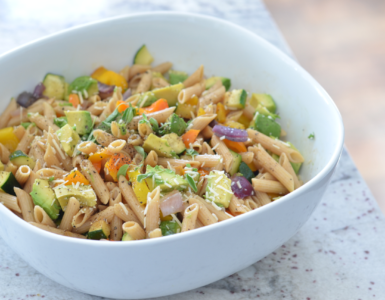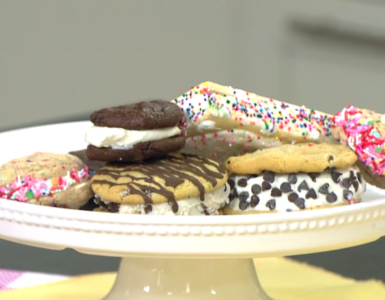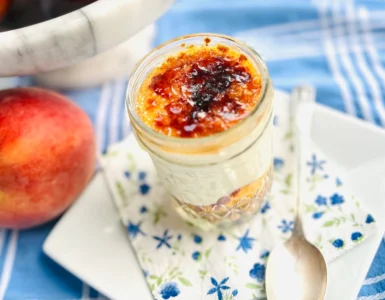Never buy store-bought yeast again. Make your family’s favorite baked goodies with natural yeast. Cookbook author, Melissa Richardson, gets you started with light, fluffy, waffles.
Natural Yeast Waffles
2 eggs
1 t. vanilla
1/4 c. milk* (add more or less to make a good batter consistency)
1/2 t. salt
1 c. natural yeast starter
cinnamon to taste.
*Non-dairy milk can be used
Mix eggs, vanilla, milk and salt in blender. Measure out starter, and mix into blender mixture in 1/3 cup increments. (This prevents the starter from becoming a dough ball in the middle of your blender). Pour batter into a hot, greased waffle iron.
Sometimes if I have them on hand, I also add blueberries or bananas to the batter. If you decide to add fruit, make sure to properly grease your waffle iron or the fruit will burn and stick to the pan.
I have a few waffle recipes in the cookbook, but here is another version that I’ve been using in my kitchen. This recipe helps me to feed my starter on time. Sometimes I’m just not ready to bake bread with starter that is ready to be used and fed- and I hate to pour any of it down the drain. This way I can whip breakfast up quick, feed my starter, and keep everything in working order.
Oh, and did I mention they are fat free, sugar free, and made in your blender?
Whole Wheat Chocolate Cake
Mix
1 c. natural yeast starter
2 c. whole wheat pastry flour
6 T unsweetened cocoa powder
¼ t. salt
1 c. water
Batter
6-14 hours later, in a Blender:
2 eggs
2 t. vanilla
1 ½ c. sugar
½ c. fresh or defrosted blueberries
1 ½ t. baking soda
Ganache Frosting:
½ cup semisweet chocolate pieces
1 cup whipped cream
Soak
(The evening or morning before you will be serving the cake):
Pour water and starter into mixing bowl and stir until starter is dissolved. In a separate small bowl, combine all the dry ingredients. Add the wet ingredients, and mix until everything is evenly moist. The batter will resemble a thick brownie batter. Cover the bowl with saran wrap or a damp towel and place on counter for 6-14 hours
Blend eggs, vanilla, sugar, salt, and blueberries until smooth. Add the soak ingredients and baking soda, blending until combined.
Preheat oven to 350 degrees. Pour batter into a pre-greased 8x8x2 square pan, or a 9 inch round pan. Bake cake for 30 minutes or until toothpick inserted into center comes out clean.
In a microwave-safe bowl or double-broiler, combine whipped cream and chocolate pieces. For microwave, heat ingredients in one minute intervals (stirring after each interval) until chocolate melts and mixes evenly into whipped cream. For double-broiler, stir ingredients constantly on medium heat until ingredients combine evenly.
Spread frosting across top of cooled cake, then garnish with more fresh blueberries. Eat immediately.
Honey Whole Wheat Loaf
1/2 c. start (stir before measuring)
2 ½ c. lukewarm water
2 t. salt
1 T coconut oil
¼ c. honey
5-6 c. whole wheat bread flour
Setting up the dough: (At least 10 hours before baking)
Combine water, start, honey, coconut oil, and salt in mixer.
Add flour 2 cups at a time, allowing mixer to incorporate flour before adding more.
Continue adding flour until dough “cleans” the sides of your mixer bowl.
(There may be residual bits near the top, and here and there along the sides, but the lower half of the bowl should be clean)
Once the sides have cleaned, allow the dough to knead for 10 minutes.
Dampen a large work surface with water and pull the dough out of the mixer bowl onto your work surface. (You want just enough water to keep the dough from sticking, but not enough to water-log your dough)
Wet your hands with water, and knead the dough a few times, until the texture is uniform.
Place dough smooth side up into a pre-greased bowl or container (remember to choose a container that allows your dough room to double in size. You can also split your dough and use two smaller bowls)
Cover your bowl with greased plastic wrap or with a thick, damp kitchen towel (thin towels dry out too quickly and stick to the dough).
Place on countertop to rise overnight, (or all day) for 6-14 hours.
Feed your start, and place in refrigerator
Shaping and Final Rise
After a minimum of 6 hours, turn dough out of bowl onto wet work surface.
Wet hands and use dough scraper or sharp serrated bread knife to cut the dough into 2 equal pieces.
Set pieces aside on a damp surface and grease your pans. (This gives your dough time to “relax” before shaping)
Take one dough section and pat it out on your damp work surface.
Shape each piece individually into sandwich loaves, artisan boules or rolls.
Allow the loaves to rise in a warm place for 2-2 ½ hours, or until the dough slowly returns a gentle fingerprint.
Preheat the oven to 375 degrees
Bake for 25 minutes, or until a thermometer inserted into the bottom of the loaf reads at least 170 degrees.
Remove from pans and allow to cool completely before cutting.
Roasted Multi-Grain Loaf
1/2 c. natural yeast start (stir before measuring)
2 ½ c. lukewarm water
2 t. salt
1 T olive oil
2 ½ c. whole wheat flour
2 ½ c. whole grain spelt flour
(If necessary add up to 1 additional cup whole wheat or spelt flour)
¼ c. roasted pumpkin seeds
½ c. roasted flax seeds, divided into ¼ cup portions
¼ c. roasted sunflower seeds
Setting up the dough: (At least 10 hours before baking)
Combine water, start, olive oil and salt in mixer.
Add flour 2 cups at a time, allowing mixer to incorporate flour before adding more.
Continue adding flour until dough “cleans” the sides of your mixer bowl.
(There may be residual bits near the top, and here and there along the sides, but the lower half of the bowl should be clean) Once the sides have cleaned, allow the dough to knead for 10 minutes.
While the bread is kneading, prepare your seeds. They can be quickly roasted on a pan in the oven or in a skillet on the stove. I roasted the flax seeds separately so that I could put them in the food processor to create more of a roasted flax seed meal. A few minutes before the end of kneading, dump your seeds into the mixing bowl.
Remove the dough and any loose fruit and nuts onto a slightly damp work surface. (You want just enough water to keep the dough from sticking, but not enough to water-log your dough)
Wet your hands with water, and knead the dough a few times, until the texture is uniform, and the remainder of the fruit and nuts has been incorporated into the dough evenly. This can take a minute or two, so be patient. Once the sides have cleaned, allow the dough to knead for 10 minutes.
Dampen a large work surface with water and pull the dough out of the mixer bowl onto your work surface. (You want just enough water to keep the dough from sticking, but not enough to water-log your dough)
Wet your hands with water, and knead the dough a few times, until the texture is uniform.
Place dough smooth side up into a pre-greased bowl or container (remember to choose a container that allows your dough room to double in size. You can also split your dough and use two smaller bowls)
Cover your bowl with greased plastic wrap or with a thick, damp kitchen towel (thin towels dry out too quickly and stick to the dough).
Place on countertop to rise overnight, (or all day) for 6-14 hours.
Feed your start, and place in refrigerator
Shaping and Final Rise
After a minimum of 6 hours, turn dough out of bowl onto wet work surface.
Wet hands and use dough scraper or sharp serrated bread knife to cut the dough into 2 equal pieces.
Set pieces aside on a damp surface and grease your pans. (This gives your dough time to “relax” before shaping)
Take one dough section and pat it out on your damp work surface.
Shape each piece individually into sandwich loaves, artisan boules or rolls.
Allow the loaves to rise in a warm place for 2-2 ½ hours, or until the dough slowly returns a gentle fingerprint.
Preheat the oven to 375 degrees















Add comment